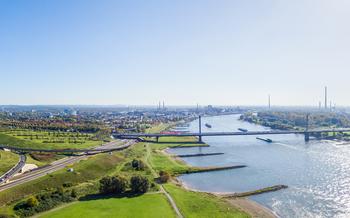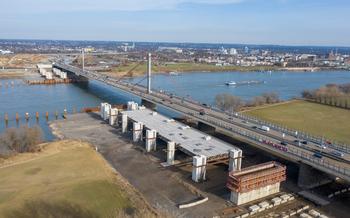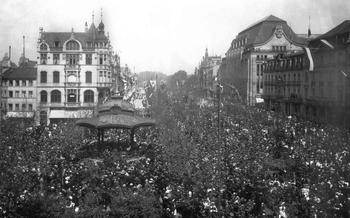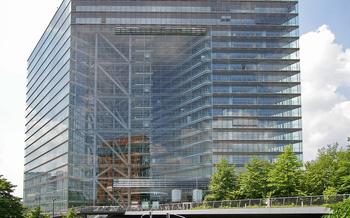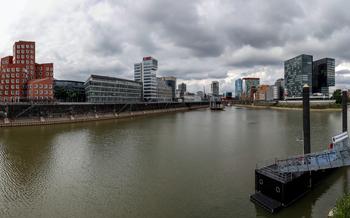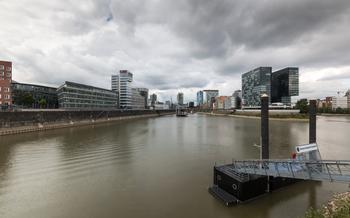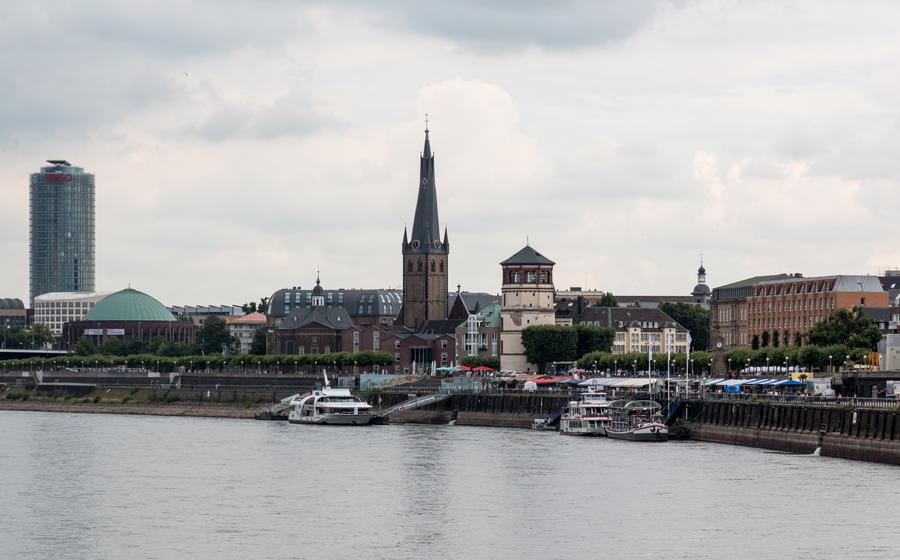
Altstadt (Old Town)
- A City on the Rhine
- Altstadt (Old Town): A Walk Through History
- Rathaus (Town Hall)
- Schlossturm (Castle Tower)
- Basilica of St. Lambertus
- Marktplatz (Market Square)
- Heinrich-Heine-Allee: Art, Fashion, and History
- Königsallee (Kö)
- Hofgarten
- MedienHafen (Media Harbor): A Transformation from Industrial to Cultural Hub
- Rheinturm (Rhine Tower): A Towering Icon
- Nordpark: A Haven of Serenity and Recreation
- Insider Tip: Düsseldorf's Altbier
A City on the Rhine
Düsseldorf, a vibrant city in western Germany, is renowned for its rich history, stunning architecture, and lively atmosphere. Situated on the banks of the majestic Rhine River, Düsseldorf has been a strategic trading hub since the Middle Ages. Its strategic location and flourishing economy have shaped its vibrant culture, which blends modernity with a deep appreciation for tradition.
History: Düsseldorf's roots can be traced back to the 12th century when Count Adolf von Berg founded a settlement on the banks of the Rhine. The city's fortunes grew steadily, and in 1380, it was granted city rights by Emperor Charles IV. During the 16th and 17th centuries, Düsseldorf served as the capital of the Duchy of Berg, a period that saw a flourishing of arts and culture.
Geography: Düsseldorf is located in the heart of North Rhine-Westphalia, Germany's most populous state. The city lies on the eastern bank of the Rhine River, which forms a natural border between Düsseldorf and its neighboring city, Neuss. Düsseldorf's urban landscape is characterized by a mix of historic and modern architecture, with the Altstadt (Old Town) serving as the city's historic core.
Culture: Düsseldorf is a vibrant cultural hub, renowned for its diverse art scene, world-class museums, and lively festivals. The city is home to several prestigious museums, including the Kunstpalast, which houses an extensive collection of art from the Middle Ages to the present day. Düsseldorf is also known for its vibrant music and theater scene, with numerous venues hosting performances throughout the year.
Anecdote: The Legend of the Düsseldorf Dragon: According to local legend, Düsseldorf was once terrorized by a fearsome dragon that haunted the banks of the Rhine. The dragon demanded human sacrifices, and the townspeople lived in constant fear. One day, a brave knight named Siegfried arrived in Düsseldorf and challenged the dragon to a battle. After a fierce fight, Siegfried emerged victorious, slaying the dragon and saving the city. In honor of Siegfried's bravery, the dragon's image became the symbol of Düsseldorf, and it can still be seen on the city's coat of arms.
Altstadt (Old Town): A Walk Through History
The Altstadt, or Old Town, of Düsseldorf is a treasure trove of history, architecture, and culture, inviting visitors to embark on a journey through time. Step into this vibrant district, and you'll be greeted by a tapestry of cobblestone streets, half-timbered houses, and historical landmarks that whisper tales of the city's rich past.
Immerse yourself in the Altstadt's captivating history, dating back to the 12th century when Düsseldorf was granted city rights. As you wander through its narrow lanes, imagine the bustling trade routes and the lively markets that once defined the city's commercial heart. Discover the stories behind the intricate facades of the buildings, each adorned with unique architectural details that reflect different eras and influences.
The Altstadt is a cultural melting pot, where the past seamlessly blends with the present. Explore its charming boutiques, art galleries, and cozy cafes, each offering a glimpse into the city's contemporary creative spirit. Take part in the vibrant festivals and events that bring the Old Town to life, from traditional markets to modern art exhibitions.
As you stroll through the Altstadt, don't miss the Rathaus (Town Hall), a symbol of Düsseldorf's civic pride and a testament to its architectural heritage. Marvel at the intricate carvings that adorn its facade, each telling a story from the city's past. And be sure to uncover the legend behind the Rathaus, a tale that adds a touch of mystery and intrigue to your exploration of the Old Town.
Rathaus (Town Hall)
The Rathaus, or town hall, is an architectural masterpiece and a symbol of Düsseldorf's rich history. Built in the 16th century, it was originally a palace for the Dukes of Berg. The imposing structure showcases a blend of Renaissance and Gothic styles, with intricate carvings and a majestic clock tower that dominates the cityscape.
Inside the Rathaus, visitors are greeted by a grand entrance hall adorned with intricate murals depicting scenes from Düsseldorf's past. The council chambers, with their ornate furnishings and vaulted ceilings, offer a glimpse into the city's political history. Guided tours provide fascinating insights into the building's history and allow visitors to admire hidden gems such as the secret tunnel connecting the Rathaus to the Electoral Palace.
The Rathaus is not only a historical landmark but also a vibrant venue for events and exhibitions. Throughout the year, the square in front of the town hall hosts concerts, markets, and cultural festivals, making it a lively hub of activity.
Anecdote: Legend has it that a secret tunnel connects the Rathaus to the Electoral Palace, which once stood nearby. This passageway was rumored to have been used by the dukes to escape in times of danger or to discreetly visit the palace's lavish gardens. While the existence of this tunnel remains a mystery, it adds an air of intrigue to the Rathaus's already rich history.
Schlossturm (Castle Tower)
A majestic symbol of Düsseldorf's rich past, the Schlossturm (Castle Tower) proudly stands as a testament to the city's resilience and grandeur. Its history is intricately woven into the fabric of Düsseldorf, dating back to the 13th century when it served as a defensive fortification for the Berg counts. This formidable tower withstood numerous sieges and wars, bearing witness to the city's struggles and triumphs throughout the ages.
Standing tall at 55 meters, the Schlossturm exudes an aura of strength and elegance. Its sturdy walls, constructed from local sandstone, have gracefully weathered the passage of time. Adorned with intricate carvings and sculptures, the tower showcases the architectural prowess of its era. Visitors are captivated by its Gothic-style windows and the striking conical roof, which adds a touch of grandeur to its overall appearance.
The Schlossturm offers breathtaking panoramic views of Düsseldorf and its surroundings. From the observation deck, visitors can marvel at the cityscape, the winding Rhine River, and the lush greenery of the Hofgarten. On a clear day, the gaze extends to the distant hills, providing a glimpse of the picturesque landscapes beyond.
Legend has it that the tower is haunted by the ghost of its former caretaker, a mysterious figure who roams the premises, forever bound to his duties. Visitors may catch a glimpse of his shadowy form or hear his faint footsteps echoing through the corridors, adding a touch of eerie charm to the tower's allure.
Basilica of St. Lambertus
A Witness to Düsseldorf's Enduring Faith
Düsseldorf's skyline is punctuated by the grand silhouette of the Basilica of St. Lambertus, a towering testament to the city's rich religious heritage. Its foundation stone was laid in the 13th century, and over the centuries, it has undergone numerous transformations, blending architectural styles from Romanesque to Gothic. The basilica's exterior is a symphony of stone, showcasing intricate carvings and sculptures that depict scenes from the Bible and the lives of saints.
Inside, the basilica's grandeur is equally captivating. The nave, with its soaring vaulted ceilings, leads the eye towards the ornate high altar, a masterpiece of Baroque art. The stained-glass windows, crafted by renowned artists, bathe the interior in a kaleidoscope of colors, casting an ethereal glow upon the sacred space.
Beyond its architectural splendor, the Basilica of St. Lambertus holds a special place in the hearts of Düsseldorf's faithful. It serves as a vibrant center of worship and community, hosting regular masses, festivals, and concerts. Its bells, pealing across the cityscape, summon the faithful to prayer and mark the passage of time.
Anecdote: A Connection to the Three Kings of Cologne
Legend has it that the Basilica of St. Lambertus is connected to the Three Kings of Cologne, whose relics are enshrined in the Cologne Cathedral. According to local lore, the remains of the Three Kings were once transported through Düsseldorf on their way to Cologne. During this time, a fragment of one of the king's bones is said to have been left behind in the basilica, establishing a lasting bond between the two cities.
Marktplatz (Market Square)
A Historical Heartbeat in the City's Core:
The Marktplatz, or Market Square, is a vibrant hub of activity that pulsates with the rhythm of Düsseldorf's history. Its cobblestone expanse is a testament to centuries of commerce, a stage where the city's story has unfolded for generations.
Once the bustling center of trade and exchange, the Marktplatz still retains its mercantile spirit. Vendors peddle their wares, offering an array of fresh produce, handmade crafts, and local delicacies that capture the essence of Düsseldorf's culinary heritage.
The square is adorned with architectural gems that speak to different eras and styles. The Rathaus (Town Hall) stands as a majestic symbol of civic authority, its Renaissance facade intricately carved with scenes depicting the city's rich past. Across the square, the majestic Basilica of St. Lambertus rises in Gothic splendor, its spires piercing the sky like celestial fingers.
But the Marktplatz is not just a place of history and commerce; it's also a social gathering place, a living room for the city's inhabitants. People congregate at the outdoor cafés that line the square, sipping coffee, indulging in pastries, and engaging in lively conversation. The air is filled with laughter, the clinking of glasses, and the sweet melodies of street musicians who serenade the passersby.
Anecdote: The Tale of the Market Square's Wishing Well
Legends whisper of a wishing well hidden among the cobblestones of the Marktplatz. It is said that if one tosses a coin into the well and makes a heartfelt wish, their desire will be granted. Over the years, countless dreams have been entrusted to the well, creating a reservoir of hopes and aspirations that permeates the square.
Whether you're a history buff, a shopper, or simply someone looking to soak up the vibrant atmosphere of Düsseldorf, the Marktplatz is a must-visit destination. As you wander through its bustling streets, let the city's spirit embrace you, and discover the stories that lie hidden within its stones.
Heinrich-Heine-Allee: Art, Fashion, and History
In the heart of Düsseldorf, Heinrich-Heine-Allee, a vibrant pedestrian boulevard, beckons with its blend of history, art, and shopping. Named after the renowned German poet Heinrich Heine, the avenue exudes an aura of sophistication and elegance.
Strolling along Heinrich-Heine-Allee, one is greeted by stately buildings adorned with intricate facades, a testament to the city's rich architectural heritage. Among these architectural gems is the Schauspielhaus, a theater known for its world-class performances and striking modernist design.
Heinrich-Heine-Allee is also a haven for art enthusiasts, with galleries and art spaces showcasing a diverse array of exhibitions. From contemporary installations to classical masterpieces, the avenue provides a vibrant canvas for artistic expression.
For those seeking retail therapy, Heinrich-Heine-Allee offers an enticing selection of boutiques and flagship stores. International fashion brands, independent designers, and specialty shops line the boulevard, catering to every taste and budget.
A stroll along Heinrich-Heine-Allee wouldn't be complete without experiencing the iconic Köbogen (Kö-Bogen), a striking architectural complex that seamlessly blends modern design with historical charm. The Köbogen features a glass-domed arcade, a luxury hotel, and retail spaces, creating a vibrant urban oasis.
Anecdote: The Kö-Bummel, a Düsseldorf Tradition
Düsseldorf's love for Heinrich-Heine-Allee is captured in the tradition of the "Kö-Bummel," a leisurely stroll along the boulevard. This leisurely promenade is a popular pastime for locals and visitors alike, who take pleasure in window-shopping, admiring the architecture, and savoring the lively atmosphere. The Kö-Bummel is not just about shopping; it's about embracing the joie de vivre that defines Düsseldorf.
Königsallee (Kö)
A Boulevard of Elegance:
The Königsallee, affectionately known as the "Kö," is Düsseldorf's premier shopping and strolling boulevard. Lined with elegant boutiques, luxury stores, and grand department stores, the Kö exudes an aura of sophistication and glamour. Stroll along this magnificent avenue and immerse yourself in the world of high fashion, exquisite jewelry, and designer labels. From international brands to local treasures, the Kö has something to offer every discerning shopper.
A Touch of History:
The Königsallee has a rich history dating back to the 19th century when it was conceived as a grand boulevard connecting the city center to the Hofgarten. Over the years, the Kö has undergone several transformations, but it has always remained a symbol of Düsseldorf's elegance and prosperity.
A Place to See and Be Seen:
The Kö is not just a shopping destination; it's also a place to see and be seen. Take a leisurely stroll along the boulevard, admiring the stunning architecture, the vibrant street life, and the stylish locals. Stop for a coffee at one of the many cafés, or indulge in a delicious meal at one of the renowned restaurants. The Kö is a place to savor the finer things in life and embrace the cosmopolitan atmosphere of Düsseldorf.
Anecdote: The Legend of the "Kö-Bummel":
The Königsallee is synonymous with the leisurely stroll, known as the "Kö-Bummel." Legend has it that in the early 1900s, a group of elegant ladies would gather on the Kö to showcase their latest fashions. They would stroll slowly along the boulevard, admiring each other's outfits and exchanging compliments. This tradition of the "Kö-Bummel" continues to this day, and visitors can often spot stylish locals taking a leisurely stroll along this iconic boulevard.
Hofgarten
A verdant oasis nestled in the heart of Düsseldorf, the Hofgarten has served as a beloved urban retreat for centuries. Its history traces back to the 16th century when it was initially conceived as a private pleasure garden for the Electors of the Palatinate. Over time, it evolved into a public park, welcoming citizens and visitors alike to revel in its tranquil green spaces.
The Hofgarten's landscape is a testament to the meticulous planning and skillful execution of renowned garden designers. Its intricate network of pathways meanders through meticulously manicured lawns, vibrant flowerbeds, and towering trees, creating a harmonious blend of formal and informal gardening styles. Visitors can stroll leisurely along the paths, admiring the vibrant blooms and the serene reflections in the ornamental ponds.
The park is also home to a treasure trove of art and sculptures. Scattered throughout its grounds are statues depicting mythological figures, historical personalities, and allegorical themes. These works of art add an air of sophistication and cultural significance to the landscape, inviting visitors to engage with the park's rich artistic heritage.
Among the most notable sculptures in the Hofgarten is the "Jan Wellem Reiterstandbild," an equestrian statue of Elector Johann Wilhelm II, who played a pivotal role in the city's development. The statue, created by Gabriel de Grupello, portrays the elector in a majestic pose, symbolizing his power and influence.
Another highlight of the park is the "Apollo und Daphne" fountain, a masterpiece of Baroque art. This captivating sculpture depicts the mythical tale of Apollo, the Greek god of music and poetry, pursuing the nymph Daphne, who transforms into a laurel tree to escape his advances. The fountain's intricate detailing and expressive figures bring the legend to life, adding a touch of drama and enchantment to the park's serene atmosphere.
The Hofgarten truly embodies the essence of a classic European park, providing a sanctuary for relaxation, contemplation, and aesthetic appreciation. Whether seeking respite from the urban hustle or indulging in a leisurely picnic, visitors to Düsseldorf can find solace and inspiration within the verdant embrace of this historic green space.
MedienHafen (Media Harbor): A Transformation from Industrial to Cultural Hub
Once a bustling harbor filled with warehouses and factories, Düsseldorf's MedienHafen has undergone a remarkable transformation into a vibrant cultural and architectural hub. In the 1990s, the city embarked on a visionary redevelopment project, inviting renowned architects from around the world to create a new urban landscape. The result is a captivating blend of modern architecture, historical remnants, and contemporary art.
Strolling along the harbor's promenade, visitors are greeted by a striking juxtaposition of old and new. The Gehry Buildings, a series of twisting and shimmering structures designed by renowned architect Frank Gehry, stand in stark contrast to the restored red-brick warehouses that once housed the city's thriving port. These buildings, now home to offices, apartments, and cultural institutions, symbolize the harmonious fusion of past and present that characterizes the MedienHafen.
Among the cultural highlights of the MedienHafen is the NRW-Forum, a renowned center for contemporary art and design. Its exhibitions showcase a diverse range of works, from cutting-edge installations to thought-provoking photography. The Filmmuseum Düsseldorf, housed in a former grain silo, offers a comprehensive exploration of the history and art of cinema, with a special focus on German film.
The MedienHafen is not just a place of culture but also a vibrant hub of activity. Its waterfront promenade invites leisurely strolls, while its numerous cafés, bars, and restaurants offer a variety of culinary delights. On warm summer evenings, the harbor transforms into a lively gathering spot, with locals and visitors alike enjoying the vibrant atmosphere.
Anecdote: The Tale of the "Gehry Buildings"
The Gehry Buildings, with their unconventional forms and shimmering facades, have become iconic landmarks of the MedienHafen. A popular local anecdote tells of the day Frank Gehry first presented his design for the buildings to the city council. The council members were initially perplexed by the unusual shapes, but Gehry had a clever response. He produced a pair of binoculars and invited the councilors to look through them. As they did, the buildings appeared to transform into more conventional forms, resembling traditional gabled houses. Gehry's playful demonstration helped to win over the council, and the Gehry Buildings were eventually approved.
Rheinturm (Rhine Tower): A Towering Icon
The Rheinturm, or Rhine Tower, is an iconic landmark of Düsseldorf, soaring majestically over the city skyline. Its origins date back to the 1970s when Düsseldorf sought a distinctive symbol to represent the city. The renowned architect H. Deilmann was entrusted with the task, and his vision resulted in this striking structure.
The Rheinturm stands as a testament to architectural prowess, combining functionality with aesthetic excellence. Its slender silhouette tapers gracefully towards the heavens, reaching a height of 240.5 meters. The tower's exterior is adorned with a web of steel cables, giving it a striking resemblance to a giant antenna. Its futuristic design has earned it the nickname "the Needle," evoking a sense of curiosity and wonder.
The Rheinturm serves multiple purposes, catering to a variety of interests. It operates as a transmission tower, ensuring the smooth functioning of radio and television signals throughout the region. Additionally, it houses a restaurant, aptly named "Top 180," which offers a unique dining experience with panoramic views of the city and the surrounding landscape. The tower's observation deck, open to the public, provides breathtaking vistas that stretch for miles, allowing visitors to marvel at the beauty of Düsseldorf from a truly elevated perspective.
Beyond its practical functions, the Rheinturm has become an emblem of Düsseldorf's vibrant cultural scene. It serves as a backdrop for various events and celebrations, including concerts, art exhibitions, and New Year's Eve fireworks displays. The tower's unique architecture has made it a popular subject for photography, capturing the essence of Düsseldorf's modern spirit.
A captivating legend surrounds the Rheinturm, adding a touch of whimsy to its imposing presence. It is said that the tower's revolving restaurant, dubbed the "Spinning Top," is home to a mischievous ghost who delights in playing tricks on unsuspecting diners. Some claim to have witnessed the tables and chairs inexplicably moving or the cutlery mysteriously disappearing, leaving guests both amused and slightly bewildered. Whether or not one believes in the ghost, the Rheinturm remains an awe-inspiring landmark that continues to fascinate and enchant visitors from all walks of life.
Nordpark: A Haven of Serenity and Recreation
Amidst the vibrant urban landscape of Düsseldorf, the Nordpark emerges as an oasis of tranquility and recreation. Established in the early 20th century, this sprawling park encompasses over 60 hectares of meticulously manicured gardens, lush meadows, and serene waterways.
Stroll along the park's winding paths, and you'll encounter a symphony of colors and fragrances emanating from the vibrant flowerbeds and aromatic herb gardens. Pause by the tranquil ponds, where graceful swans glide effortlessly across the water's surface, and the gentle sound of fountains provides a soothing backdrop.
For those seeking adventure, the Nordpark offers a plethora of recreational opportunities. Embark on a leisurely bike ride along the designated cycling paths, or lace up your running shoes and follow the jogging trails that meander through the park's verdant expanses. If you're traveling with little ones, let them loose in one of the many playgrounds, where they can climb, swing, and slide to their heart's content.
A highlight of the Nordpark is its miniature railway, a beloved attraction that has delighted generations of visitors. Hop aboard one of the charming trains and embark on a scenic journey through the park's picturesque landscapes.
Insider Tip: Düsseldorf's Altbier
Düsseldorf's brewing tradition dates back to the Middle Ages, and its signature beer, Altbier, is a testament to the city's rich brewing heritage. This top-fermented beer is characterized by its distinctive copper color, malty flavor, and hoppy aroma. Altbier is an essential part of Düsseldorf's culinary culture and is best enjoyed fresh from the tap in one of the city's many traditional breweries or pubs.
One of the most popular Altbier breweries in Düsseldorf is Füchschen, a family-owned business that has been brewing beer since 184Füchschen Alt is a classic example of the style, with a balanced flavor profile that showcases the beer's malty sweetness and hoppy bitterness. The brewery offers tours and tastings, providing visitors with an immersive experience into the world of Altbier brewing.
For the ultimate Altbier experience, visit Düsseldorf during the annual Altbier Festival, held every July. This lively festival celebrates the city's brewing tradition and features a wide variety of Altbier from local breweries. With live music, food stalls, and plenty of opportunities to sample different Altbier varieties, the festival is a must-visit for beer enthusiasts.
Whether you're a beer connoisseur or simply looking to experience Düsseldorf's local culture, be sure to try a glass of Altbier. This delicious and refreshing beer is a true taste of the city, and its unique flavor and aroma are sure to leave a lasting impression.
